- Home
- Barbara W. Tuchman
Stilwell and the American Experience in China, 1911-45 Page 8
Stilwell and the American Experience in China, 1911-45 Read online
Page 8
To assemble a force capable of acting as an independent army Pershing’s training program had to be continued in France. Besides the staff for GHQ, staffs had to be organized for future corps, each to be composed of four divisions plus one in reserve and one in depot. A corps, when filled out, would contain about 6,000 officers and 170,000 men, larger than the entire peacetime Army before the war. The direct need was for staff officers at division and corps levels, and since they did not exist, they had to be made. A General Staff school as well as schools for other arms and branches was established at Langres near American GHQ at Chaumont, southeast of Paris.
Contemplating these beginnings of war without an existing General Staff, the Allies felt added reason to urge the integration of American combat troops within their system. To organize a General Staff in the European sense with plans drawn for mobilization and campaigns “takes thirty years,” a French general told Pershing. “It never took America thirty years to do anything,” Pershing snapped.
Stilwell was assigned first to brief duty with the British 58th Division to acquaint himself with actual conditions at the front before taking the Intelligence course at Langres. He reached the headquarters of this division at Noyon, furthest penetration of the Hindenburg Line, on February 10, 1918. Around him was desolation: villages in ruins, some marked only by the foundations of walls and debris; the ground everywhere intersected by old trenches and pitted with shell craters. The staff of the 58th, his first active Allies, he found both obnoxious and agreeable. “These English are beyond me—most of them so very pleasant and some of them so damn snotty…too god-damned indifferent and high and mighty to bother about an American officer.” He contrasted them unfavorably with the French, whom he found willing, polite and helpful: “Me for them.” He spent five days with the British becoming acquainted with every operation of a frontline sector—trenches, dugouts, OPs, night patrols, camouflaging of roads, study of maps and aerial photo reconnaissance. Observing, learning, talking and taking notes, he sufficiently forgot his annoyance with his hosts to wire for permission to stay an extra day and to note gladly, “They said OK!”
A brief stay at Langres coincided with that of Colonel Henry L. Stimson, former Secretary of War under President Taft, now at fifty an Artillery officer, who as Secretary of War a second time was to be a significant figure in Stilwell’s future. With the need acute at Chaumont, Stilwell was pulled out after a week to assist in the organization of the G-2 section at GHQ. After three weeks he was again reassigned for schooling of a direct kind to the French XVIIth Army Corps at Verdun. Here half a million men, attackers and defenders, had died over the past two and a half years. Here the French slogan, “They shall not pass” had been born and the “sacred road” for supply and reinforcements kept open. The threatened German breakthrough was barred, yet as if uncontent with the greatest slaughter the world had ever known, the guns still fired.
In a skirmish on March 20, the day Stilwell arrived, the French suffered 20 casualties and there were 42 dead Boches in front of one small sector. The Colonel made him feel welcome, arranged for him to join a bridge game after dinner and, unlike the British, did not avoid personal conversation. “Are you married?” he asked. “Have you children? Are they yours?”
While he was at Verdun the front further to the west erupted under a gigantic assault. This was the opening of the great German offensive of 1918, Ludendorff’s fierce effort to end the war in a last grasp at victory before American forces could be brought to bear. His armies were now reinforced by an extra 42 divisions released from the Russian front, whereas the Americans at this stage had added no more than eight divisions to the Allied armies, of which four were still in training camps. Ludendorff’s aim, for which every reserve of strength had been assembled, was to split apart the British and French, and by a series of offenses at different points rather than a single head-on collision, use up the Allies’ depleted reserves and break through their defenses at last.
Lasting with intermissions from March through July, Ludendorff’s effort almost succeeded. The Germans smashed through Allied lines for the largest territorial gains since the beginning of trench warfare, took prisoners and inflicted casualties by the hundreds of thousands, recaptured Noyon 60 miles from Paris, brought Paris under bombardment by long-range cannon, flung the British back against the Channel and in May came again to the Marne where they had been foiled of victory four years before. The crisis forced the Allies into the last resort which they for so long, through so much vain slaughter, had evaded: unified command, to which Foch was named on March 27 in the midst of battle. Even Pershing gave way and allowed American units to serve temporarily under Allied command. Thrown into these battles to help stem the German advance, American divisions fought at Château-Thierry, Belleau Wood and Cantigny.
At Verdun, where he remained for six weeks, Stilwell had no share in the first stage of this drama. He was assigned to the office of Major Armand Belhomme, the G-2 section chief of the XVIIth Corps, but spent the major part of his time out on rounds of forts and command posts which were still under daily bombardment. From a dugout beneath the death-filled pile of Fort Douaumont he saw a “lunar landscape….The whole terrain is churned up, a mixture of wire, tools, shoes, shells, bones, uniforms, cartridge boxes, grenades, helmets, wheels, stakes, iron fragments…plentifully sprinkled with lime up front to keep down the boche cadavers.” Inside the underground tunnels of Douaumont the place was damp, muddy, stinking and impossible to keep clean. At Fort Vaux fog enabled him to wander in front of the lines where he saw “heads lying around still in helmets, hunks of bodies, thigh bones, jaws, hands, pieces of old rags hanging to them” and in a dugout a leg sticking out on which a soldier had hung his musette.
One patrol took him within 60 yards of the German lines and he returned at 2 A.M. after being on foot since 9 A.M. “Fell in mud holes, boche fuses going up all the time, munitions gang at work, all the night life of the front.” After being trapped by shelling all day in a dugout just big enough for two with, as he judged, 150 to 200 77s coming over, luckily aimed too low and to the left, Stilwell’s comment was, “Very interesting day.” This was not false bravado for he never hesitated to write in his diary “scared to death” when that was how he felt. “Scared” generally meant fear of attack or capture or anticipation of something to come, whereas being under fire seemed not to bother him. During the many reconnaissance trips they made together when action was heavy, Major Belhomme wrote long afterwards, “we learned to appreciate his culture, his cartesianism and his equanimity.”
His French hosts made him acquainted with all departments of staff work in the corps, with infantry work in the line and with the functioning of the intelligence service at every echelon. He was the first American to serve with the XVIIth Corps and his command of French opened the way to cordial relations. “They treated me like a long-lost brother,” he wrote to his wife, “showed me everything and took me everywhere.” His experience was like that of the correspondent Heywood Broun, who wrote at the time, “The Frenchman is the ideal soldier. Not only can he fight, but he can tell you about it.” A flight was arranged for Stilwell in an observation plane, and though he got dizzy in the course of a spiral, he decided the aviator’s was a soft life, “clean clothes, no wind, short hours, agony over quickly, back for lunch.”
Food, as always, interested Stilwell and the recording of meals in his diary was a lifelong habit. At the XVIIth officers’ mess they appear to have been worth recording. One evening he dined at the mess of Colonel Cantau, a bald, fat officer of sixty who wore an enlisted man’s cap, rows of decorations, hazed the servants, ate well and “doesn’t give a damn.” It being a meatless Friday, the meal consisted of two kinds of omelet, fish and rice, vegetable salad, white and red wine, champagne, two cordials and cheese. The orderly was made to salute and announce, “Madame est servie.” When Stilwell asked why Madame, the Colonel asked in turn, “Are you married?” “Yes.” “Where is your wife?” “In the Uni
ted States.” “No, she is in your heart; therefore she is here. That is why I have him announce, ‘Madame est servie.’” It was no wonder that Stilwell found the French sympathetic. His own wife was much on his mind and he recorded the receipt of every letter.
On his departure to return to Chaumont he was sent off with a flourish at a farewell party tendered by the corps staff with three chefs de bureau heading a full mess, and flowers on all the tables. A wonderful centerpiece of nougat crowned with the French cock and the American eagle decorated his table; champagne flowed all evening and flattering speeches made him blush. All insisted on having his signature on their menus and he was presented with an inkwell made of a Boche shell and a picture of himself among the staff with everyone’s names signed on the back. One officer was moved to write a poem which he left on Stilwell’s desk. Glowing from a sense of being liked and appreciated, Stilwell replied in slangy and fluent French, thanking them for all he had learned and promising that among all the emmerdement awaiting him at Chaumont he would look back to his good friends of the XVIIth “with all the pleasure in the world.”
He returned to American GHQ on April 29 in the rather sour expectation of red tape, poor food and stuffed shirts. He hated the time spent as “a damned waffle-tailed clerk in a bloody office…grinding out rot about things I know nothing about and surrounded with desks and typewriters and stuff.” The coming and going of line officers, many junior to him at West Point and already lieutenant colonels or colonels while he was still a major, was galling and served as a constant reminder of the faster promotion that went with command of troops at the front. His efforts to obtain line duty were frustrated by the greater need for capable staff officers. Certain officers from civilian life sporting superior rank were another irritant, including one described as a “shifty-eyed smiler from the Peanut Club.” The Peanut Club was Stilwell’s designation for “millionaires, politicians, and social darlings who have been given commissions of Major and up, and soft jobs.” During the intense fighting for the bridgeheads of the Marne Stilwell’s desk-tied frustrations grew. “Things look bad….Talk of giving up Rheims….French and British howling for our troops….At office, deadly as usual.”
At last a transfer came which put him at the heart of the American offensive planned for the reduction of the salient at St. Mihiel. For the next eight weeks Stilwell’s task was to prepare the intelligence operations for the coming action and to organize the divisional G-2s as well as the schools to train their staffs. The work kept him constantly on the move from one divisional headquarters to another and back and forth to Chaumont, Langres and IVth Corps headquarters at Neufchâteau.
Information on enemy lines and defenses inside the salient had to be collected, estimates of enemy strength calculated from various indications, daily and weekly summaries of enemy artillery fire distributed, topographical surveys issued, maps on various scales and grids made and delivered. Fifteen tons of maps were ultimately prepared for St. Mihiel.
Meanwhile in the desperate resistance to the Ludendorff offensive the tide had turned; initiative passed to the Allies who moved into counterattacks all along the line, restoring old positions. The enormous German effort since March, which had broken the deadlock, swallowed up miles of territory and inflicted almost a million casualties, had used up its strength and in so doing plowed the ground of its own defeat. While Ludendorff acknowledged as much to the Kaiser on August 8, Foch was planning the series of attacks by which he expected to end the war in 1919. The first was to be the American assault on the St. Mihiel salient scheduled for September 7.
To conduct the assault Pershing, on August 10, formed the First Army, the grand objective of all his planning, of which Stilwell’s IVth Corps was one component. Totaling 500,000 men (including one French corps), it was the largest force so far assembled under the American flag and its action was to be the first major battle planned by an American staff. A major part of the planning was the work of the First Army’s Assistant Chief of Staff for G-3, Lieutenant Colonel George C. Marshall, who was to play a definitive role in Stilwell’s career. The salient to be taken was a triangle with sides 25 miles long and a 35-mile base. It had been fortified since 1914 by successive bands of barbed wire, concrete pillboxes and dugouts, tunnels in the hills, narrow-gauge railways and carefully selected field-gun and machine-gun emplacements for crossfire. In the effort to achieve tactical surprise the Americans attempted the secret concentration at night of 14 divisions along with their supplies, but security was ragged and the movement was soon being talked of in the streets of Paris. “Worked away on the big dope,” Stilwell recorded. “Great secrecy here and barber at Neufchâteau knew all about it….Any boche plane who cannot see our bustle and preparation must be blind. Trucks rushing back and forth, columns of men, railroad trains, autos, motorcycles, etc.” He was on the move day and night, visiting OPs for a view of the terrain and going up in a balloon for a wider view.
Visiting the divisions made him “homesick for soldiering,” the more so as he did not find the company congenial at corps headquarters with its “son-of-a-bitch cavalry club running things.” In contrast to the congenial atmosphere of a French mess and the fun and carousing with friends at Langres, he was as bored and irritated at the IVth Corps mess. “Terrible session at chow with old B. Was bored to death, meal was endless.” His disparagements would become particularly heated after he had brought visitors to dinner, as if he were ashamed of the lack of interesting conversation. Then the diary growled with references to the “gloomy” or “punk” or “G-D bromide, uncongenial, s.o.b. mess.” Stilwell could never suffer bores at all and was made instantly impatient by fools, snobs, stuffed shirts or anyone he conceived to be such.
On September 11, the day before the battle, his promotion to lieutenant colonel came through. Rain had been falling steadily, heightening the tension on the eve of the American test. Stilwell sat up all night finishing last odds and ends. The IVth Corps had never fought as a corps before but it contained two of the AEF’s oldest and most battle-wise divisions, the 1st and the 42nd (“Rainbow”) Division, of which Douglas MacArthur was Chief of Staff. Poised on its right was the 1st Corps, commanded by General Hunter Liggett.
In darkness artillery opened the battle. “Out at 1 A.M., as the first big one boomed over by St. Mihiel. From then on till 5 the sky was one continuous flash of light….Our men moved up to the jumpoff trenches through the muck and rain. At 5 they went over and from then on it was one continuous round of phone calls and messages. Steady, rapid progress everywhere….Everything went beautifully. Les exécutants put it over….1st and 42nd came through beautifully. 89th sadly lacking through some skullduggery or other.” He went down to the 89th’s command post to see what was the matter and found “a hell of a condition—no reports.” In contrast, at 1st Division command post there was “a quiet capable appearing bunch….The wounded lying outside, howitzers going full blast, tanks, infantry moving up in good style through the shrapnel, boches pulling out, guns going….French sergeant very enthusiastic, ‘Magnifique! Magnifique!’ ” He escorted some enemy officers from a large haul of prisoners back to the prisoners’ cage for interrogation, then went out again to investigate the caliber of shells reported to be bombarding Toul. “Our planes owned the air today, all the Woevre towns on fire. First day’s objectives all passed and pushing on to second day’s….Got sore and blew up topog. section and was ashamed of it afterward….1st and IVth Corps had entire success. Great day.” The IVth had in fact met sterner resistance than the 1st but reached all of its objectives by noon of the first day.
In the wake of the advance Stilwell made his way through burned-out tanks and trucks, overturned gun carriages, refugees, dead horses and all the strewn litter of war to examine enemy emplacements, and stayed up two nights in a row to write his summaries. While officers gathered for critiques of the action, the general enthusiasm was high. The wiping out of the oldest, strongest and last German-held salient gave a great lift to Allied morale
even though the enemy at St. Mihiel was not, as General Liggett wrote, “at his best nor his second best.” Composed largely of second-class replacements, the German troops were inferior in number to the Americans and low in morale. Although American performance fell short of expectations in plan and execution, the battle had a decisive effect: in demonstrating to the Germans that an American Army was a reality in the field, it made plain the inevitability of defeat. Hope of a stalemate against the worn-out British and French, permitting at least a satisfactory peace, faded in the face of a new army. From this point on, with desperation lending them fury, the German effort was to fight for withdrawal to a position from which they could negotiate and avoid surrender.
Apart from his work as G-2, Stilwell carved his initials on the battle in a moment of inspiration known as the Schmeercase affair. In the early stages of the battle, when reports were meager, his fellow G-2 at 1st Corps, Colonel Sherman Miles, kept calling him every hour for news of any special developments until Stilwell, exasperated, suddenly obliged: “Yes, the great Otto Schmierkäse, the German bichloride gas expert, has been captured.” Great excitement at the other end of the wire: “Spell his name; spell bichloride.” Hardly expecting such success for a fiction with the German name for cottage cheese, Stilwell was caught up by his own invention. He added details of such verisimilitude that Colonel Miles announced he was sending over his gas officer to interview the prisoner and hung up before the hoax could be confessed. When the gas officer arrived, it was explained to him that Dr. Schmierkäse had just five minutes before been sent back under guard to G-2, First Army, for interviewing. Thereafter the elusive prisoner had to be kept one move ahead of would-be interviewers. Word of Stilwell’s hoax spread through corps and division headquarters, causing some hilarity at the expense of Colonel Miles who not unnaturally resented it. Picked up by Reuters, the Schmeercase (as it was now spelled) report appeared in the papers of Paris, London and New York, establishing as history that “One of the leading German gas experts has been captured by the Americans according to word from the St. Mihiel front. He was arranging a gas projector when nabbed.” To his wife Stilwell wrote, “Otto is my own creation and I am getting more proud of him every day….Everybody in AEF knows Otto now.”

 Practicing History: Selected Essays
Practicing History: Selected Essays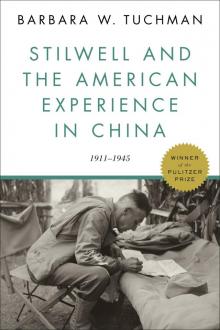 Stilwell and the American Experience in China, 1911-45
Stilwell and the American Experience in China, 1911-45 Bible and Sword: England and Palestine From the Bronze Age to Balfour
Bible and Sword: England and Palestine From the Bronze Age to Balfour The Guns of August
The Guns of August The Proud Tower: A Portrait of the World Before the War, 1890-1914
The Proud Tower: A Portrait of the World Before the War, 1890-1914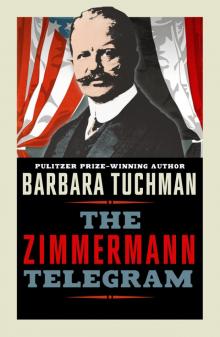 The Zimmermann Telegram
The Zimmermann Telegram A Distant Mirror: The Calamitous 14th Century
A Distant Mirror: The Calamitous 14th Century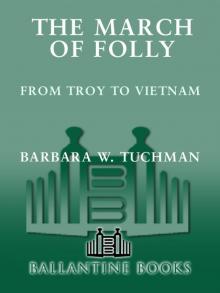 The March of Folly: From Troy to Vietnam
The March of Folly: From Troy to Vietnam The First Salute
The First Salute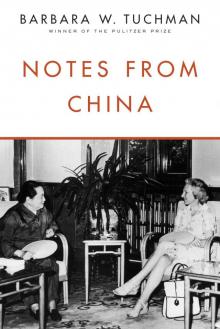 Notes From China
Notes From China Practicing History
Practicing History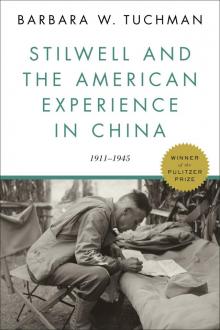 Stilwell and the American Experience in China
Stilwell and the American Experience in China First Salute
First Salute Bible and Sword
Bible and Sword